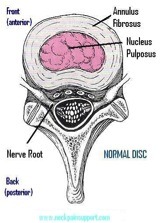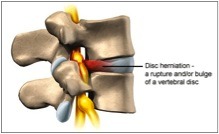The problem
- The cervical discs sit between the vertebrae (bones) of the neck
- The disc is usually irritated as a result of overloading/over stretching of the annulus at the back portion of the disc. This may occur due to repetitive bending of the neck, poor posture or heavy lifting and can be associated with whiplash injuries.
- Cervical disc injury may present as a strain, stretch or bulging of the annulus at the back of the disc.
- In the most severe cases, the gel like material in the middle of the disc may herniate the annulus (leak out) causing irritation to the surrounding neural tissues.
Interesting facts
- The commonly used term “slipped disc” is misleading. The disc is firmly attached to the vertebra above and below and cannot slip or move.

- Cervical disc injuries usually occur in the neck between the 5th and 6th and the 6th and 7th cervical vertebra.
- Problems with the spinal discs are very common and most prevalent in people between the ages of 25 to 45.
- With appropriate management and exercise this is not necessarily an ongoing injury.
What you can expect/look out for
- Pain in the neck and/or radiating down the arm.
- Numbness in the arm or fingers.
- Weakness or loss of co-ordination of the arm, hand or fingers.
- Nerve pain, which is usually experienced as an intense burning sensation in the area of the body supplied by that nerve.
Hints for self-management
- The back portion of the disc is strained when the neck is in forward flexion (chin to chest), as such this movement should be avoided.
- Anti-inflammatory medication can be useful in calming down an irritated disc and/or the nerves that it has been pressing on. (Consult your GP before taking anti-inflammatory medication).
- Lying on your back with a rolled up towel under the neck can also help to settle an inflamed disc, as long as it is comfortable to do so.
Management options
- Physiotherapy and appropriate exercises have been shown to effectively manage cervical disc injuries.
More information
- The cervical disc is usually injured as a result of poor postural habits or muscle control in the neck.

- If your injury persists, you should seek advice and exercises from your physiotherapist to strengthen the neck and improve your posture. This will both help to settle your injury and prevent re-occurrence of the problem.
At Sydney Physiotherapy Solutions our highly qualified physiotherapists specialise in the assessment, treatment and prevention of neuromusculoskeletal injuries.
Contact us today – 9252 5770
This handout was prepared by Sydney Physiotherapy Solutions and is intended as a general information service. Please note that the information provided is not intended as a substitute for advice from a registered physician or healthcare professional. If symptoms persist, please consult your doctor.

